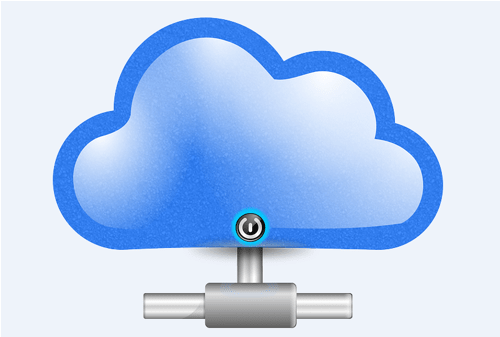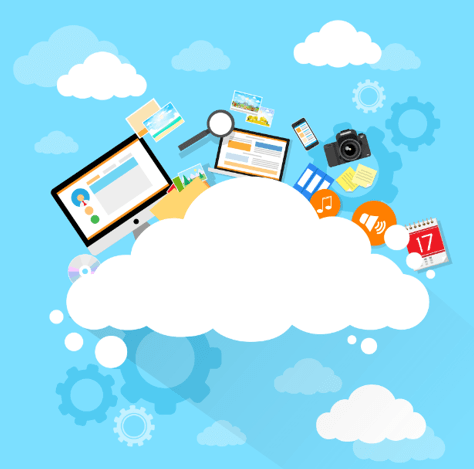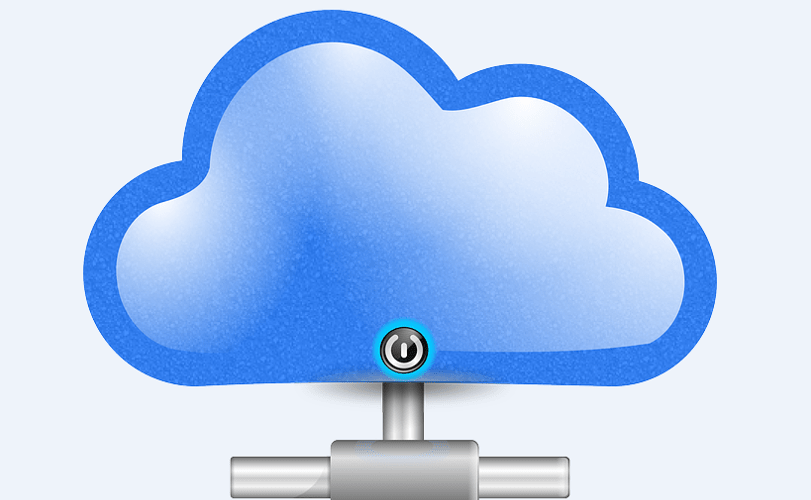What Is the Cloud? And What is Cloud Computing?
According to a Citrix Cloud Survey Guide, when people were asked “what is the cloud”, a majority of them referred to it as the sky, or something related to weather.
But what is Cloud Computing?



What is Cloud Computing?
When defining cloud computing, it is useful to think of it as a data storage system that offers users (individuals or companies) computing resources via the Internet.
Originating in the Internet technology industry, “the cloud,” as it’s referred to, is becoming a common resource for the general public, but there are many misconceptions about how the cloud works and what it does.
This article will further clarify the cloud definition and explore what cloud computing is.
See Also: US Small Businesses – Why Are Small Businesses Important?
How Does the Cloud Work?
Now that we’ve clarified the question, “What is the cloud?” let’s explore a related question: How does the cloud work?
Essentially, through cloud computing, users can access virtual online storage and processing instead of relying on hardware, such as drives or servers, to maintain their files. Using what is referred to as a layered network, cloud computing connects Internet-enabled devices –computers, tablets, smartphones, and other wearable technologies – to resources in a centralized data center.
Before cloud computing was an option, businesses that had large amounts of data storage also had to maintain and store their own hardware on-site. Due to this, the staff needed to maintain this data and equipment could also be quite costly, and it usually far exceeds the fees associated with cloud storage companies.
There are several characteristics of cloud computing that makes it a compelling option:
- By avoiding paying for an IT professional, you or your company can access computing services only when required.
- It allows multiple users to access the same software without extra fees normally associated with multiple use.
- Cloud computing is multi-platform, which means it’s accessible and can be synced through any Internet enabled device.
- Cloud usage is based on demand that considers the actual amount of storage utilized of the client, which may vary month by month.
- Payment for this flexible usage is determined based on what amount of storage is actually utilized.
Public, Private, Hybrid and Community Systems
Beyond contemplating the questions of “What is cloud computing?” and “How does cloud storage work?” companies have several options to consider in choosing what model is right for their needs. One important concern for companies transitioning to cloud computing is whether to implement a private, public, community or hybrid system.
More specifically, the decision between public and private cloud computing is crucial. Public cloud computing is defined as services offered by companies that provide rapid access to affordable computing resources via a publicly accessed network.
Purchasing public services allows users to avoid buying hardware, software, and other storage infrastructure. The storage company itself already owns this equipment and has the capacity to take on hundreds of thousands of companies while maintaining the privacy of each. The IT requirements (maintenance, security, and scale) are handled offsite.
Public cloud systems also offer:
- Software-as-a-service (SaaS) apps for needs such as transaction management, data analytics, and more. An estimated 59% of the total cloud workloads will be SaaS by 2018, up from 41 percent in 2013.
- PaaS for cloud-based applications
- IaaS for storage and computer services when required
Understating private cloud computing will help in clarifying the question of how cloud computing works more generally. A private cloud provides larger businesses with the infrastructure to operate their storage on one central system – hosted either internally or externally. They have the same time and space efficiencies but offer more control in relation to resource management and multi-tenancy.
Don’t Miss: Top Rated Providers of Cloud Computing Services
All-in-One Change Management Tools
Top Rated Toolkit for Change Managers.
Get Your Change Management Tool Today...
Private clouds are excellent for organizations with their own servers, software, and IT staff and are, for many large businesses, the key for how cloud computing works. The characteristics of private cloud computing include but are not limited to:
- Automated management of storage, middleware, and analytics
- Use of a self service system to control service, making rapid IT service easier for staff
- Security and maintenance requirements tailor-made to meet company needs and expectations
No understanding of the cloud definition would be complete without knowledge of hybrid clouds. This option offers a viable alternative for businesses with complex computing and storage requirements or may provide a stopgap measure for a transition from private to public. Basically, hybrid cloud systems combine the integration of public cloud services with the company’s private IT resources. They are preferred by some companies because they:
- Facilitate the upkeep of sensitive info in private data clouds
- Allow for flexibility in services depending on the sensitivity of the data
- Have the benefit of accessing public cloud resources, like SaaS and IaaS
Essentially, hybrid clouds provide a foundation with two separate systems that talk to each other. Click here for more information about the specifics of hybrid systems (cloud bursting, load balancing, etc.) if you’re still wondering about how cloud storage works.
Finally, community cloud computing is formed by several companies with similar storage needs who pool resources to create a cloud system. System such as these are effective in industries such as health care, where patient records need to be protected from the public but also readily accessible to several separate but related organizations.
Related: Cloud Computing Examples – Get What You Need!
The Benefits of Cloud Computing
Any business aiming for productivity and relevancy will eventually need to implement cloud computing to stay competitive. Recent figures show that cloud computing generates approximately $100 billion per annum, and this figure is increasing annually. It will be imperative for businesses of all sizes and from diverse industries to understand how the cloud works.



How Does the Cloud Work?
One of the reasons these systems are appealing is that they save space. Businesses no longer have to maintain clunky hardware (and the energy it consumes) on their premises.



It’s also worth noting that the cloud acts as an equalizer. Whether you’re a small startup or a big company, cloud computing democratizes access to software applications. By limiting the impediments created by the technical need to maintain equipment, cloud computing providers make it possible for companies of any size, with limited or unlimited resources at their disposal, to access similar computing properties via the cloud. In this sense, the cloud definition works to the advantage of small and large businesses alike.
To summarize, the essential benefit of cloud computing for businesses is that it allows a company, regardless of size or type of needs, to customize its approach to IT to meet the specific demands of that company. The details of maintenance and staffing are, for the most part, met by the cloud provider – an essential component of the cloud storage definition.
Sometimes, the benefits of cloud computing are unanticipated. For example, a company could initiate a cloud system with the intention of increasing productivity for individual workers and discover that the sharing capabilities also increases productivity with group projects, facilitates collaboration or enhances customer satisfaction.
One of the biggest strengths of cloud computing has been its ability to facilitate work across communities and groups of people in ways not previously accessible. Questions can be posed to entire communities of employees, and visual resources can be accessed and shared with ease.
For many companies considering how cloud computing works and whether to make the switch to cloud computing, the clincher might be its role in analytics. There are an increasing number of options available through cloud providers that focus on understanding, swaying, and forecasting consumer decision-making.
In conclusion, the main benefits of cloud computing include the resources facilitated at the level of both the individual and the group. It also allows small or large companies to increase the scale and accessibility of their IT. By eliminating or reducing the administrative needs and costs for a company, cloud computing simplifies the IT process.









Concerns about the Cloud
Switching over
Despite the clear arguments in favor of cloud computing, it can be an extensive process of consolidation to make the shift from on-site to cloud. Many older organizations have already established systems in place and have strictly allocated resources and budgets dedicated to IT, along with a jumble of equipment, applications, and operating systems in use.
These kinds of exiting systems – often referred to as “legacy spaghetti” – cannot be automatically transferred over to the cloud and require planning and simplification prior to the switch.
Understanding the cloud definition can also be beneficial in terms of economic gains. Cost is another determining factor in making the switch to cloud computing. For companies considering putting their entire data set on the cloud, it would be cheaper in the long run. Other studies show that initial costs of this switch will be a deterrent.
However, perhaps focusing on cost is ill-advised. Many businesses don’t spend a large percentage of their operating costs on IT, so this increase in the percentage does not mean a large overhead.
In addition, the infrastructure of building and operating a company is headed in the direction of cloud computing, and, therefore, this initial cost can be considered a necessary long-term investment. Cloud computing providers purchase their equipment and power in large amount and, due to this, are able to charge less for their services than it would cost for companies to run them privately.
Popular Article: Nolo – What Is Nolo? How It Could Save You!
Security Issues
Cynics of cloud computing claim that the system is not as secure as independently managed IT systems. In understanding how the cloud works, companies must also realize that firewalls can be breached and passwords hacked. Even those with the responsibility of running the software can steal information.
While it’s true that systems are occasionally breached, every computer system relies on similar security system guidelines – even the ones that are privately operated. The only way to guarantee complete security is to not rely on computers for your business, which is a virtual impossibility in a competitive business. Unless you want to monitor threats consistently, it is worth considering leaving this task to a private business that specializes in information management and storage.
For many businesses, of course, security is more complicated than just keeping outsiders from their information. It also means creating barriers within the company. Documents may only be shareable with certain members, for example.
On-premise computing is capable of handling these demands with ease while it seems to be a challenge for some loud computing service providers. The reason for this issue is that cloud computing was originally designed to facilitate sharing between small groups of people and not within complex, hierarchical organizations. Although this setback is slowly being remedied, it is worth considering if your business requires many layers of security and privacy.
Read More: Advantages of Cloud Computing – Why Cloud Computing?
Free Wealth & Finance Software - Get Yours Now ►
The Future of the Cloud
These doubts regarding costs and privacy concerns will certainly deter some companies from migrating over to cloud computing. However, if current trends toward cloud computing continue on the same path and more and more companies continue to adopt this innovative approach to information storage and accessibility, the cloud will continue to refine.
Consequently, the cloud computing definition will also evolve along with the practices. It’s just a matter of time before cloud computing becomes the de facto service model for IT departments.
Image sources:
- https://cdn.pixabay.com/photo/2013/07/13/11/42/cloud-158481_960_720.png
- https://static1.bigstockphoto.com/0/6/8/large2/86002643.jpg
AdvisoryHQ (AHQ) Disclaimer:
Reasonable efforts have been made by AdvisoryHQ to present accurate information, however all info is presented without warranty. Review AdvisoryHQ’s Terms for details. Also review each firm’s site for the most updated data, rates and info.
Note: Firms and products, including the one(s) reviewed above, may be AdvisoryHQ's affiliates. Click to view AdvisoryHQ's advertiser disclosures.





